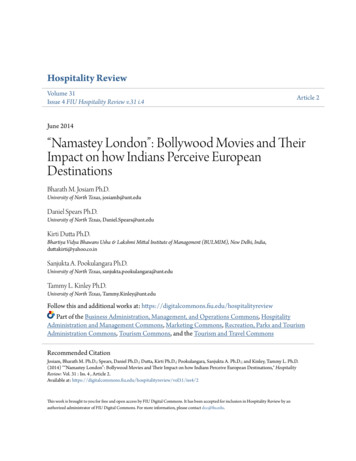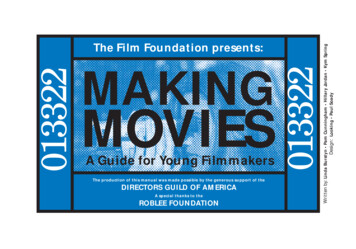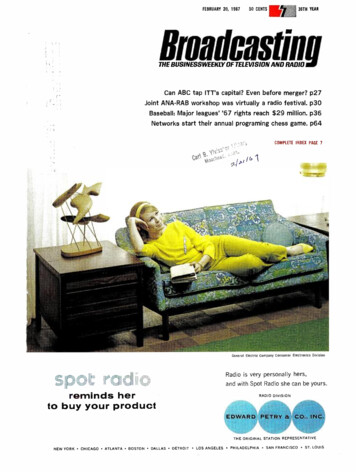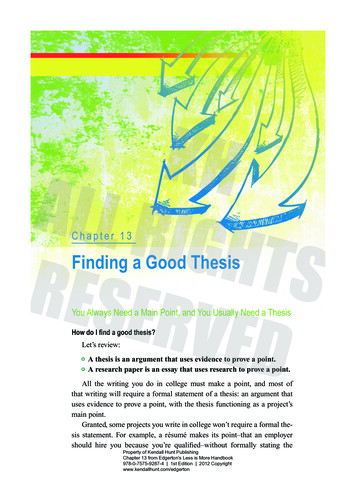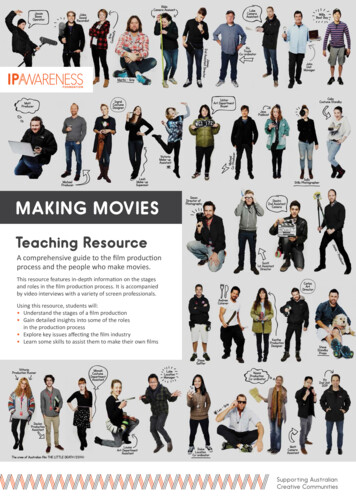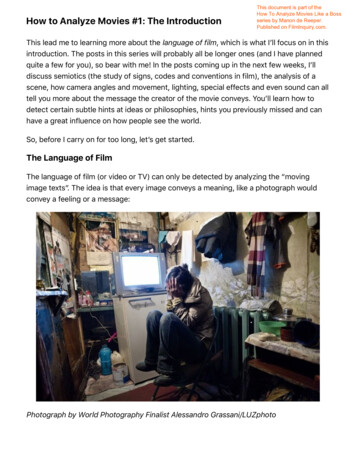
Transcription
How to Analyze Movies #1: The IntroductionThis document is part of theHow To Analyze Movies Like a Bossseries by Manon de Reeper.Published on FilmInquiry.com.This lead me to learning more about the language of film, which is what I’ll focus on in thisintroduction. The posts in this series will probably all be longer ones (and I have plannedquite a few for you), so bear with me! In the posts coming up in the next few weeks, I’lldiscuss semiotics (the study of signs, codes and conventions in film), the analysis of ascene, how camera angles and movement, lighting, special effects and even sound can alltell you more about the message the creator of the movie conveys. You’ll learn how todetect certain subtle hints at ideas or philosophies, hints you previously missed and canhave a great influence on how people see the world.So, before I carry on for too long, let’s get started.The Language of FilmThe language of film (or video or TV) can only be detected by analyzing the “movingimage texts”. The idea is that every image conveys a meaning, like a photograph wouldconvey a feeling or a message:Photograph by World Photography Finalist Alessandro Grassani/LUZphoto
With a picture, it’s a little easier to distill its message than with a movie. You just have oneframe or scene to analyze, the “image text” is the message it is trying to convey. In thiscase, that would probably be a sense of desperation, sadness, to illustrate thecircumstances this person is in. You can tell a lot about this person’s life from just lookingat this picture (for what is the actual context and story behind the picture, click on theimage).Just like one would read a book, one can “read” a movie – though instead of reading theactual text, you have to distill the “text”, its meaning, from the (moving) images. It’s likethey say: a picture is worth a thousand words, and that’s certainly the case with a movie.Meaning of Film and Decoding ItThe film language is how the movie “speaks” to its audience. Those who create themovies (the great coöperation of directors, producers, editors, et cetera) want to tell acertain story, transfer a certain idea. Even if they just aim to entertain, their movie willlikely carry some meaning, because the audience can create meaning, even when it’s notthere. This is called decoding. We “decode” a story’s meaning, just like we would interpretspoken language or written texts. We take to a movie all our previous experiences and ourknowledge and subconsciously apply it to what we see – we interpret the film with preexisting expectations.We can’t watch a movie in a vacuüm – we will always relate what happens in a movie tothings we experienced in our own lives (e.g. you can relate to a mother getting a baby, apair going through a divorce, a teen going to school, etc.), or even relate the movie to amovie we’ve seen before. On the one hand, film reflects how we think about certain issues(political, social, economical, what have you), but on the other hand, film also molds theway we think about those issues.The Window on the WorldWhat makes a movie so infinitely compelling to us – curious creatures as we are – is that itoffers a “window on the world” – it creates a (appearance of) reality. It’s like peekingthrough the window when you hear commotion in your street, or (collectively) slowingdown on the high way to watch when an accident happened. The guessing what thecommotion will lead to is what fascinates us.In the 1920s and 30s, movies were considered “truth machines”, able to reveal certainsocial and political truths. In the 1960s, famous French philosopher Jean Baudrillard saidthat fiction as well as non-fiction are merely simulations. Today, though, it’s understood
that film should not be compared to reality, either to measure the gap between reality anddeption, or to measure the accuracy of the depiction. Instead, we should look at howmovie and reality are related to each other: movie draws from real life, but also influencesit. It’s not so much about the gap between movie and reality, but the interaction betweenthem. Lines between reality and fiction have blurred (and not just in film!).The Book Thief (2013) – Behind the ScenesNo depiction in a movie is objective or neutral. This is why we can’t speak about a movie’s“truth”, “reality” or “authenticity”: film is in the eye of the beholder.And on a final note Not only does film entertain, it also informs us and even educates us about the worldaround us, and most importantly, persuades us to see the world in a certain way. Most arenot aware of this persuasion, but if you are, trust me, it’s so much fun to encounter,analyze and criticize the way the movies persuade us into thinking about things in acertain way. It gives watching a movie a whole new dimension, which is what I enjoy aboutfilm most of all. Although, I have to admit that some movies carry meaning I do soabsolutely not agree with that it can be a tad frustrating that people are not aware of theway they’re being influenced. Nevertheless, the deeper understanding of the world thatfilm analysis can offer is, in my opinion, definitely worth it!
Next in this series is How To Analyze Movies: Signs, Codes & Conventions. I’ll discusssemiotics, the study of meaning in a film through decoding symbols and conventions.Do you enjoy thinking about or discussing the meanings of a movie after you’vewatching it? How do you go about “reading” a movie’s meaning? Can you thinkabout any movies that have made you understand the world better, even fiction?If you’re enjoying our How To Analyze Movies series, and would like to get access to themall – as well as our entire archives and newest content, become a member and join theawesome community of Film Inquiry! Feel free to use the AnalyzingFilm coupon code for a10% discount!SubscribeSome books and articles I used for this article and can heartily recommendBen-Shaul, N.S. (2006). Film: The Key Concepts. Oxford: Berg Publishers.Campbell, E. (2010). The Future(s) of Risk: Barthes and Baudrillard go to Hollywood.Crime Media Culture, 6(1), 7-26.Dowler, K., Fleming, T. & Muzzatti, S. L. (2006). Constructing Crime: Media, Crime,and Popular Culture. Canadian Journal of Criminology & Criminal Justice, 48(6), 837-850.Kohm, S. A. (2009). Naming, shaming and criminal justice: Mass-mediated humiliationas entertainment and punishment. Crime Media Culture, 5(2), 188-205.Rafter, N. (2006). Shots in the Mirror: Crime Films and Society. New York: OxfordUniversity Press.
How to Analyze Movies #2: Signs, Codes & ConventionsThis is part two in the How to Analyze Movies series (find part 1 here!), and today we’ll bediscussing the signs, codes and conventions in a movie that can tell you a lot about themessage that the creators are trying to convey.Some creators are very aware of the use ofsigns, codes and conventions in their movies, though some are not – then the symbolismis there but not on the surface, which makes it a little harder to interpret.Semiotic AnalysisThe study of these signs, codes and conventions in movies is called semiotics. Semioticanalysis is a way to explain how we make meaning from codes – all meaning is encoded inthat which creates the meaning. No object or word goes without a meaning – we cannotread or see something without associating it to a certain idea – the meaning. In ouryouths, we have all been taught how to decode what we see, read and hear, we have alllearned to decode meaning.However, what we should realize is that the decoded meaning is not our own idea, butsomebody else’s. For example. If you read the word “failure”, you decode it by relating it tothe value your culture adheres to the concept of failure and its antonym – success.Although it’s not said we cannot create meaning on our own, 99% percent of the time, themeaning comes from some pre-established (cultural) idea.Signs and CodesIn semiotic analysis, the smallest units of meaning are signs. For example, the way youdress is, to others, a group of signs that tells them something about you – clothingencode the smallest of signs, e.g. your popped collar means you’re preppy. Your band tshirt and over-sized pants are signs that you are a music fan, but together create a groupof signs (t-shirt baggy pants maybe even black nail polish?), a code, that suggeststhat you are perhaps also a bit of a rebel.
Everything here signifies that Juno is really rebellious.You could say meaning has two “levels”. On its most basic level, there is the sign: thedenotation, which is the literal meaning. But when a sign occurs in a group, or in aparticular context, it becomes a code, and it can suggest or connote extra meaning. Forinstance, the color red simply denotes a color, but in a certain context it can connoteemotion, like anger, or love. These codes are often used in media to reinforce, subtly, theway we should think about certain things or how we should behave (a culture’s dominantideologies), i.e. a long-standing cultural ideology is that diamonds (or chocolate)represent love and that you give this to your significant other to relay it.These codes are groups of signs that seem to fit together naturally. Together, they createmeaning. To stick to the signs of romance: the sign of a broken heart means lost love, putthem with the sign of a boy and girl and together, you know that together these signs –the code – mean this couple broke off their relationship.In FilmTo create filmic code you need a lot of equipment – cameras, microphones, lighting, etcetera. Four types of signs and codes exist in semiotic analysis of film:Indexical Signs
These are the most basic. Indexical signs indirectly point to a certain meaning – they actas cues to existing knowledge: e.g. smoke means fire, panting means exercising, a ringingbell means end of class. This type of signs are constantly used in (all types of) media andare really very common.Symbolic CodesSymbolic codes often denote something they have nothing to do with. For instance, thered heart symbolizes love, the white dove symbolizes peace, the color green symbolizesjealousy.In Blade Runner, they used a lot of dovesIconic Signs and CodesThese are the literal signs and codes: a cop means a cop. They are meant to appear likethe thing itself. However, they always represent more than just the thing itself. When wesee a cop, we also associate this with our cultural ideas of “justice” or “the law”, or evenmasculinity or toughness. These codes also reinforce the ideas we have about theseconcepts in our culture, it reinforces the ideological meaning of those concepts.Enigma CodeThis is an important type of code used in film: it creates a question which the film “text”
will then go on to answer. This is often used in trailers of movies (as well as the posters):they create a question to create curiosity and intrigue the viewers – with the intention ofmaking people want to see the movie.ConventionConvention is another important term and concept. It indicates the “establishment”, theestablished way of doing something, or understanding something. It’s what we see asnatural, we’re so used to these conventions that we don’t even see them anymore, anddefinitely don’t see what their effect is, or how they affect us. However, they are nothingbut natural! Conventions like the following are often culturally accepted, but if youscrutinize them, they’re not at all like reality.Phyllis Dietrichson in Double Indemnity (1944) – a real film noir femme fataleIn film, convention can be recognized in how women are portrayed. For instance, in filmnoir, they are either the helpless dame in distress, or the femme fatale – there is no inbetween. Or, in how a cop or the bad guy are portrayed: like when a cop can kill bad guyswithout consequences, and the bad guy has not a grain of good in his heart.Moreover, genre and narrative can add to the sense of convention (like the film noir), justlike the way a movie is edited or certain shot types (e.g. a close-up of the poor dame indistress).
CultureAs I’ve already mentioned once or twice before – culture is very important in the way weinterpret signs and codes. It is important to realize that culture always determines themeaning a sign or code communicates. Your interpretation of a Bollywood movie, if you’reanything other than an Indian, will most likely be very different to the interpretation of anIndian.Practice!Recently, I reviewed Only God Forgives, a movie by director Nicolas Winding Refn. Thismovie is riddled with signs, codes and convention – it is incredibly symbolic. Go watch it ifyou haven’t yet and practice semiotic analysis – read my review afterwards to see ifyou’ve picked up on some of the symbolism, too. You’ll see – most people consider OnlyGod Forgives a tough and boring movie to get through, but if you dig in a little deeper, itgets a lot more interesting.What are some of your favorite codes or symbols? Do you often pick up on them orare you usually unaware of them? If you have any questions at all, please let meknow in the comments!If you’re enjoying our How To Analyze Movies series, and would like to get access to themall – as well as our entire archives and newest content, become a member and join theawesome community of Film Inquiry! Feel free to use the AnalyzingFilm coupon code for a10% discount!Subscribe
How to Analyze Movies #3: Mise-en-Scène & EditingIn the last part of How to Analyze Movies, we discussed signs, codes and conventions. Inthis episode we’re moving on to the scene and editing, and what that means in filmlanguage.Mise-en-ScèneEverything you see in a movie or TV episode is constructed to fit in the screen. Thecreators think about every element that is shown in that scene, nothing is accidental(generally, of course, I’m leaving mistakes out of the equation). By controlling what isshown in the boundaries of that screen, the creator controls the understanding of theaudience. All that the director puts into the scene and films is called the “mise-en-scène”.To help you analyze as well as understand a scene, you have to ask who and what is inthe scene and consider their relative position – also think of make-up, expressions,costume, scenery, appearance, props, sounds and lighting.Bane in The Dark Knight Rises (2012)Questions you have to ask yourself:What effects are created in a mise-en-scène?What meaning do they have (connotation and denotation – link)?
How were they created?Why were they created in that way -what is the director’s purpose? (e.g. to developa character, set the mood, increase realism, to explore the deeper meanings of theplot and theme)You could try this out with the image of Bane, above.EditingEditing is a way to compress time and space into one coherent, natural-lookingsequence of shots. It’s usually seamless. It consists out of cutting and joining pieces(shots) of recorded film together, while still maintaining a sense of continuity andconnectedness. Usually, shots are edited to suggest a realistic flow of what’s happening.A montage is a series of edited shots that works as a cohesive unit, which has greatermeaning than the individual mise-en-scènes.There are different kinds of editing techniques:Continuity editing: with this technique, the editor tries to keep the sense of realisticflow of events and to create a coherent sequence of shots. It is the most commonediting technique.Jump-cut: this is a dramatic cut in the flow of events, which breaks the time/spacecontinuum (which is why it’s considered a violation of continuity editing), yet it stillfeels natural. Quick jumps between camera positions that differ only very little is anexample. It can also give the sense of jumping forward in time. This technique isused in creating music videos (to increase dynamischheid), and it was also usedfamously in Guy Ritchie’s Snatch. (Video example)Cross-cut: in this editing technique, two action scenes quickly succeed each otherto create a sense of two scenes happening at the same moment in time, but in adifferent place. The complete sequence of these kinds of scenes is called parallelaction. Christoper Nolan is famous for using this technique a lot, it’s usedextensively in The Dark Knight and The Dark Knight Rises, as well as Inception.(video example)Follow-cut: in a follow-cut, the action is followed to its consequence. An example iswhen you see a character look out over a certain view, and the next shot shows theactual view.
Here you’re shown the perspective of Mr Bennet: his wife and daughters (Pride &Prejudice, 2005)Fades and dissolves: this type of editing promotes the sense of scenes (and time)moving forward. It’s usually a gradual transition from one image to another. Fadesfade to or from a blank image and can fade-in, fade-out, or fade to black. Dissolvesare a transition between two shots.Sound-bridge: this entails the carrying of sound between two shotsUnderstanding the different kinds of shots also leads to a deepened understanding of thepurpose of the director and the meaning he or she is trying to present.Next time you watch a movie, make some notes on what you see in the mise-enscène and consider why it was put there, and also look at the way the movie wasedited. What does it do with the meaning of the film?If you’re enjoying our How To Analyze Movies series, and would like to get access to themall – as well as our entire archives and newest content, become a member and join theawesome community of Film Inquiry! Feel free to use the AnalyzingFilm coupon code for a10% discount!Subscribe
How to Analyze Movies #4: Considering The CameraIn the earlier installments of How To Analyze Movies, we discussed film language, howmeaning is created in film through the use of signs, codes and conventions and mostrecently, we covered mise-en-scène and editing.Today, we’re going to discuss the camera and how it too can create meaning and howimportant it is to know about the way the camera is used to analyse a movie. First, we’lldiscuss the different kinds of shot types, then the camera angles and finally, cameramovement.Shot TypesA shot is one single take. It can be used to set the scene or the mood, or place thespectator in the scene.First, there is the establishing shot. This is a long shot that helps to set the scene. Itestablishes the location of the scene and gives the audience an idea of where they are inthe narrative.The establishing shot is frequently followed by a mid shot, to zoom in on the focus of thescene. A mid shot is usually considered to be a view of a full-length human, although insome styles, like in European film, a shot of a person from the waist up is considered amid-shot, whereas this type of shot is, in other styles, often already considered to be aclose-up. So in that case, a close-up can range from a shot of a person from the kneesup, from the waist up, or merely the face.
source: Artisan EntertainmentFinally, there is the subjective point-of-view (POV) shot, an eye-line shot where thespectator sees what the characters sees, which helps give the audience the feeling theyare part of the scene themselves.Camera AnglesCamera angles can greatly help set the tone of the movie, and signify meaning nearlyalways. A great example is when the angle is a subjective POV shot with a high angle,suggesting that the person that’s the subject is superior to the one viewed from up high,and a low angle shot can signify weakness.You’ll often see this in movies where ranks are important, for instance, when an emperoror king sits high up his throne and the POV high angle shows him looking down over hissubjects.Camera MovementFinally, camera movement. Camera movement too is very important in the creation ofmeaning. For instance, a zoom into a close-up of someone’s face can suggest a certainemotion or emphasize on it.Panning across a field of war can suggest endless chaos, just like a POV handheld camerashot creates tension and increases involvement by adding to the feeling of the spectatorbeing part of the action. Using a steadycam can help prevent a handheld camera from
giving too shaky shots. However, some filmmakers prefer the shaky shots instead.source: Artisan EntertainmentLastly, the following shot tracks or pans the the subject to keep him or her in shot – often,in this case, the camera is attached on rails or on a wheeled platform, a “dolly”.PracticeRequiem of a Dream (2000) is a great example of a movie in which shot types, cameraangles and camera movement are used significantly to create meaning, involve theaudience, to display and evoke emotion.Watch the four minute trailer below and consider all we discussed above.
Requiem For A Dream - TrailerAn example of a significant shot is around 1:10, where we see the television set, shot frombelow, giving us the sense that it’s a powerful thing – and it is, to the mother whose wholelife is about that television.Tell me, what else do you see in this trailer, regarding the camera? How does itsplacement and use create meaning?On a random note, I saw Requiem of a Dream when I was very young, and it probablydestroyed any appeal drugs could ever have to me. Great movie to show your kids toscare ’em. And isn’t it still an amazing soundtrack? It still gives me a dry throat.If you’re enjoying our How To Analyze Movies series, and would like to get access to themall – as well as our entire archives and newest content, become a member and join theawesome community of Film Inquiry! Feel free to use the AnalyzingFilm coupon code for a10% discount!Subscribe
How to Analyze Movies #5: Lighting, Sound & ScoreLast week we covered the Camera, in which I reminded all of you of one of the mostdepressing but best shot movies ever. This week in How to Analyze Movies: Lighting,Sound and Score! Seriously, don’t forget about these three if you’re analyzing a movie.They’re important. Let’s get started.LightingLighting is important in a movie to create a certain mood, or an atmosphere. You may notexpect it but even lighting can add to and create meaning in a film. Horror movies, forinstance, are known use lighting to create the mood a lot. Most importantly, they use a lotof shade to create the setting and the atmosphere. They are codes of meaning. Certainly,you will never see horror-type lighting in a romantic movie, as it doesn’t fit the setting. Inlighting, available light suggests natural light. Spotlight, although mostly used in theater,picks out one member of a group, but is sometimes used more subtly in film, and could beused for foreshadowing. Full-face lighting highlights a face and can suggest opennessand truth. Shadow and low contrast are often associated with fear, anger, suspicion, etcetera.source: New Line Cinema // Lord of the Rings: Two TowersHigh-key lighting is harsh and bright, and can uplift the movie’s mood. It can alsointensify a scene where emotions are laid bare, as the high-key lighting makes it look as ifthe person cannot hide anything – especially when they also make use of full-facelighting. Soft-key lighting is, as the name already suggests, a much softer light, shadowsare visible and contrast is lower. It’s often used to create a romantic atmosphere, or to set
a more grim mood in darker movies. Watch this fascinating lighting in video tutorial ifyou’re interested in learning more about lighting – tutorials are very handy to get a deeperunderstanding of what it is the filmmakers do and how they achieve it (and why!).Sound and “Diegesis”There is a difference between sound that is in the scene when shot, and the sound that isadded after the movie is shot. The former is called the sound of “the world of the film”, ordiegesis. Examples are singing birds or cars driving by in the background, a baby’s rattletoy, or screeching tires in a car chase. Those sounds are diegetic. Not-diegetic aresounds that are added to a film after the film is shot to create mood and atmosphere, likethe sounds of blowing wind, rumbling thunder or blows in a fist fight. Moreover, sound canalso be dubbed. That means the sound is already in the diegesis but is replaced by aclearer recording of the sound, to emphasize on and exaggerate the effect of the sound.The ScoreNever forget to consider the score. The movie’s music goes a great length to set themood. A horror will rarely feature a romantic ballad, though they may sometimes have avery cheerful song to create contrast with what’s happening on screen. This too is doneto create that mood and atmosphere. Blade Runner is a dark and mysterious movie, setin a very dark, dystopian world. The score created by Vangelis really emphasized on thatmood, even giving it a dream and trance-like feel, adding to the mystery and surreality ofthe movie. In fact, another movie that did this well was the movie we discussed last week,Requiem of a Dream. The score for this movie truly added to the dark mood anddesperation of the characters.
source: Warner BrosA great example of a perfect accompanying score for a tense action scene is thecombination of Juno Reactor’s Mona Lisa Overdrive and the orchestra in The MatrixReloaded during the freeway chase:The Matrix Reloaded: Trinity on Ducati 996Do you ever pay special attention to sound and lighting when you’re watching amovie? What is your favorite movie score – and which did you think didn’t fit themovie you were watching?
If you have any questions or comments, please post them below!If you’re enjoying our How To Analyze Movies series, and would like to get access to themall – as well as our entire archives and newest content, become a member and join theawesome community of Film Inquiry! Feel free to use the AnalyzingFilm coupon code for a10% discount!Subscribe
How to Analyze Movies #6: Story & GenreTo learn how to analyze a movie, aside from understanding the camera, lighting andsound, editing and the signs and codes of film language, you need to know how story andgenre can tell you about the message the creators intend to share with their audience.Story (or Narrative)Stories are infinitely important to us human beings. We use “schemas” to make sense ofour world – we organize events and our surroundings into certain categories to structurethe world we live in. Story plays a large role in our making sense of the world. We learnabout action and reaction, cause and consequence and many types of people. Stories areoften told following a certain form and structure, no matter whether the story is fiction ornon-fiction. We’re so used to stories as a tool to recount events, we don’t even knowwhen it’s used! The power of narrative, however, is that it can create an illusion ofauthenticity.The basic template of storyMost stories are told through a few always-returning elements: the three acts – beginning,middle and end.Texas Chain Saw Massacre (2003) before the shit went down – source: New Line CinemaFirst, the world is presented as a calm, stable place. All is well, until the second act starts:the calm and stable world is rudely disrupted, often by a villain. Now, the hero has to
resolve the issue and make sure the world returns back to normal. The end will show thehero did just that. We’re used to this kind of structure and in fact, expect the disruption tobe resolvable and the world to be able to return back to normal.Story versus RealityIn story, the characters are often presented as wholly good and wholly evil. The hero vsthe villain. In the real world, however, most people aren’t as black or white, but are manyshades of grey. In the real world, conflicts and issues aren’t as easily resolved as storiesoften present them to be. Story teaches us about the world; after all , it is (presented tobe) a window on the world, showing us situations and people we may not everexperience or meet in real life.We unconsciously take story to be true, and with that, our view on the world can beskewed. We have to realize, constantly, that “story” is something applied liberally andgenerally – it’s not just in books and movies, even non-fiction is presented like a story, aswell as the news. News can give one as unrealistic view on the world as a movie can.Story in MovieWhat we need to be aware of in movie analysis is how the story has been constructed.While the most basic story structure exists out of a beginning-middle-end, has a hero anda villain, certainly not all movies follow this structure. If they don’t, know what it is themakers are trying to tell you.The Maltese Falcon – source: Warner Bros.
For instance, film noir has often drifted away from the original story structure to point uson the fact that in reality, the world is grey and that the end is not always a happy one –not all issues can be resolved.GenreGenre is the kind of narrative, or story, being told. Genre is just as important as story onits own – it manages our expectations and schemas. When we watch a horror, we link itautomatically to all we know of the horror genre, and with that we have certainexpectations of the movie as well. This isn’t only limited to the events within the story, butincludes its characters and settings. Moreover, it helps us predict where the story will leadto.For example, when I pick a random horror movie, I’d expect it to be set in a forest or in anold, dingy house – of course in the middle of the night, so that the setting is rich inshadows. I’d expect there to be a screaming blonde cheerleader, some sort of trashytough guy and a nerdy smart dude, and I’d expect there to be a lot of blood, gore anddeath. That’s how specific expectations regarding movies can get.Texas Chain Saw Massacre – source: New Line CinemaThrough genre, directors can create a seeming reality. It makes us fail to see what isreality and what is a media convention – for instance, to stick to the horror genre as anexample, in reality, it may be the cheerleader that will save people from a tough situation.In film, she’s always presented to be the victim, but in reality, she doesn’t have to be.Use of Genre by F
awesome community of Film Inquiry! Feel free to use the . AnalyzingFilm . coupon code for a 10% discount!Subscribe. Some books and articles I used for this article and can heartily recommend. Ben-Shaul, N.S. (2006). Film: The Key Concepts. Oxford: Berg Publishers. Campbell, E. (2010). The Fu


